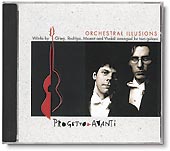 |

Concerto in D major
Antonio Vivaldi (1678–1741) (1678–1741)
During his last 40 years the Italian Antonio Vivaldi wrote an astonishing 750 works, of which more than 450 were concertos. It wouldn’t be unfair to say that the concerto form itself, with a fast first movement, a slow middle movement and a brisk final movement, was more or less “invented“ by Vivaldi, and it has been the standard for concertos ever since.
The four concertos that together constitute ‘The Four Seasons’ are undoubtedly some of his best known works (yes, they are on our schedule...) but this small concerto for lute and strings is quite often performed as well. The solo part is technically easy to play, and the form structure is not very complicated. Throughout the piece Vivaldi uses an A1A2B1B2 form in each movement, and according to the custom at that time the performer was expected to improvise a development of the melodic line in the repeats. Once upon a time this was a way to show of one’s ‘musical macho’ and they even had competitions in it, but now it is not such a big deal. Just do as many rock musicians do: if you can’t improvise well enough, compose an ‘improvisation’ – at least that’s the way we did it...
In both the outer movements we use the rasguado – a technique classical guitar playing has borrowed from the Flamenco music – and there are no such things in the original score. In the third movement we use it to magnify an orchestra tutti, but in the first we replaced a few accompaniment bars in the solo part with it just for the fun of it. May Vivaldi’s soul forgive us!
Booklet text 1 2 3 4 5 6 (Booklet Text Index)
Back to Orchestral Illusions
Back to Orchestral Classics for Two Guitars
|



 (1678–1741)
(1678–1741)